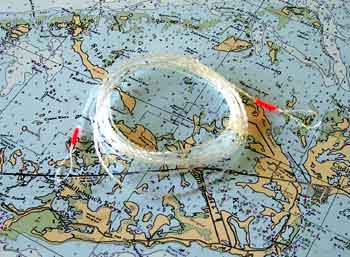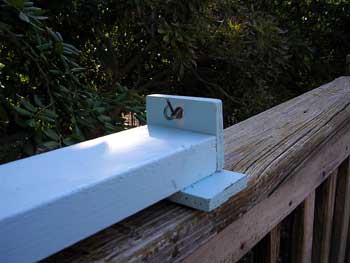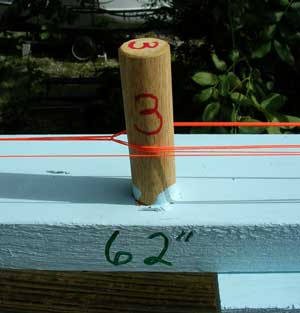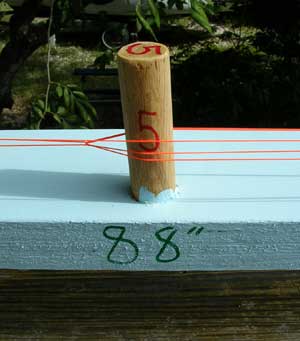A Case for the Furled Leader
FLY FISHERPERSONS are a unique breed. They come in a multiplicity of sizes and shapes, yet share a passionate devotion to the outdoors and a fierce loyalty to an exclusive kind of fishing. After that, the differences are mostly differences of opinion. Fly fishers have unyielding commitments to particular makes and models of rods and reels, and intense views about choices of backing, working line, and flies appropriate to various conditions. Fly fishing is eminently personal.
If there is one thing we become downright dogmatic about, it is the construction of our personal leaders, made so by our choices of knots and their relative distribution. Considering the controversy surrounding knots of choice, weight and brands of monofilament appropriate for various fish and conditions, and ratios of step downs, the writer knows that when he suggests a strangely different kind of leader construction, he can expect no small amount of polite derision. As I begin A Case for the Furled Leader, I am reminded of a statistics professor who entered class the first day looking even more uncomfortable than the rest of us. He fumbled with the feared textbook and — after a long silence — remarked, “I find it hard to justify beginning a semester teaching you things I suspect you will reject in the end.”
If you happen to take a liking to a furled, tapered leader, you can make one with approximately 90 feet of monofilament and the instructions in this article. Sounds like a lot of mono for a ten-foot leader, but think of how many you can make from one 500-yard spool. I inquired about one I made for a friend, just last evening. He reported that he caught over a hundred fish using it, most of which he caught after he got a wind knot in it. (Incidentally, furled leaders resist wind knots.) My friend said he retired the leader after a year, recently, and was glad I brought it up, because he wanted another. I was flattered and so I made him one. Actually, they are quite easy to make, once you get the hang of it.
Now I’ll tell you how I furl leaders as good as I’ve seen.
Why Consider Trying a Furled Leader?
If you are a knot lover, even the thought of tying a knot-less leader might trouble you. But there are some distinct advantages. A furled leader tapers smoothly from butt to tippet. Additionally, a furled leader has no memory (at all). It is as limp as a dishrag. In saltwater fly fishing, folks who swear by single-strand monofilament leaders with multiple complex knots might be convinced that a furled leader is simply out of the question. Consider, however, that furled leaders don’t kink. They have a superior shock absorption that in single-strand leaders is usually incorporated into class tippets (near the fly). Too, they turn over more smoothly than any step-down, knotted leader can. They land on the water like a butterfly. Nothing against a good knotted leader, but the step-downs are abrupt, and the knots can and do collect grass and slime.
But rather than chance overdoing the hype, let’s make one, and you decide if it has merit.
Making a Furled Leader
First, you need to make a jig. You may think any leader that requires a jig isn’t worthwhile, but keep in mind that you’re tying a leader that could very well last you through hundreds of fish. And the jig itself should never wear out.
The jig shown in the illustrations that follow is needed to maintain and control multiple strands of very small monofilament. Variations of placement of dowels are possible, but all serve the same purpose: to hold the monofilament while you assemble the various “paths” of the individual strands. (A good analogy might be a weaver’s loom.)
Any 10-foot 1″ X 4″ or 2″ X 4″ will do fine. Begin by affixing a piece of 1″ or 2″ stock to one of the boards as a “footer”, using wood glue and staples or nails. Various sources call for two or three cup hooks screwed into this headpiece for attaching the strands. I prefer one hook only…as opposed to moving greatly twisted lines from hook to hook when doing additional procedures.
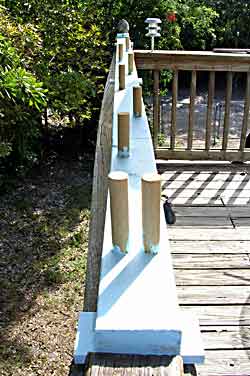
The jig with the dowels in place, looking toward the cup hook at the far end. Note that I’ve chosen a porch railing as convenient place to set up my jig.
Next, you’ll need to place some dowels at strategic places for wrapping strands of mono. An old broom handle is perfect. Likely it will be 1″ in diameter, and you can drill 1″ holes and tap 3″- or 4″-long dowels in place. A small amount of wood glue holds them in place. What you will be doing is locating two rows of dowels at different intervals that will effect a smooth taper when the strands are furled together. Sources vary regarding spacing the dowels. This boils down to individual preference and as you’ll see it can greatly effect the final “topology” of the leader. This is why furled leader making ranks only slightly beneath fly tying in personal appeal, rigid loyalty, and guarded esoterica. You could get creative, but I’ve tried many variations and suggest that with your first jig you don’t, until you see just how the dowel spacing influences the construction.
Mark and drill your dowel holes at the following distances from the footer board. Note that each successive peg should be aligned to either side of the board, parallel with your final two pegs at 114″:
- 32″
- 48″
- 62″
- 74″
- 88″
- 100″
- 114″
Finally, two finishing nails are also placed in a parallel position 4 or 5 inches back toward the footer. These are needed to hold your spun strands, which we’ll talk about later.
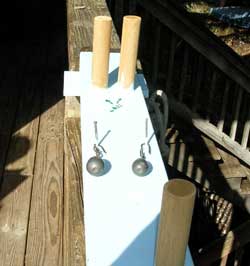
A view of the finished jig from the opposite direction showing the position of the two finishing nails and the two weights rigged with hooks that will be used to keep tension on the furled strands.
You need to fashion one last necessity for your jig. Take two, 2-ounce fishing weights and attach wire hooks to the weight eyes. These will be used to retain tension on your spun monofilament strands while you do subsequent steps.
Beginning the Leader
The instructions that follow will make a leader appropriate for most shallow salt-water fly-fishing. I’m not a particular guy when it comes to monofilament, but likely you have a preference because you have field tested them all, read numerous articles, and even built a breaking strength measurement device. I have developed a small preference for P-Line Fluoroclear because it is a copolymer having a fluoro coating and the price is right (Wal*Mart has it; note how the price compares to regular fluorocarbon). Some folks have reported they prefer 6#-12# monofilament, but don’t be tempted. You’ll end up with something Tarzan could swing on. After wasting a few miles of mono, I have decided that 4# P-Line or “anybody’s” 4# will make the best furled leader. As an aside, trout fishers have been receptive of furled leaders for nearly a century. Ask a trout fishing enthusiast if he/she has heard of furled leaders, and you will learn that they were made at the turn of the century from horse tail hair, later silk thread, and currently with 2# or smaller mono. It won’t be all that easy to find 4# mono in salt fishing environs, but big-box retailers like Bass Pro and Wal*Mart have served me well. (Please note that in the accompanying photographs I substitute orange 30# Dacron for the smaller line for illustration purposes.)
OK, here we go. You’ll want to begin with at least 90 feet of line on your spool so that you have enough line to complete the leader. Start by tying an overhand loop in your tag end. Make it easy on yourself by making the loop comfortably big (approximately 1-1 ½”). Hook this loop on your cup hook and, keeping a small amount of tension on your line, make four loops from the hook around the first peg, then come back to the first peg. (You should have four strands on either side of the first peg.)
Run the line past the peg, and down to the third peg (skipping the peg on the other side of the board), then loop the line around the peg and through the first set of loops 3 times; you’ll be passing the spool and standing line through the loops you created around the first peg.
Continue down to fifth peg and loop the mono back to the previous peg two times.
Now run the line to the appropriate peg at 114″ and back through the loops at 88″ one time, returning to the peg at 114″ and making a full turn around it.
You are now at the final peg. If you’ve done everything right, you’ve kept your mass of looped line from jumping off of a peg (which it will do if you are not careful to keep slight tension on your loops or if you raise up and pull a group off its peg prematurely).
At this point you have one turn around the final peg … and a spool in your hand wondering what to do next. Make a couple more turns around the 114″ peg to hold it in place, then tie a loop in the line six inches or so beyond the peg — a surgeon’s or a simple overhand knot, as before, will do nicely. Go ahead and cut the spool off at this point, remembering to keep tension on the standing line as you do so. Now remove your temporary wraps from the last peg while holding the looped end out straight at the end of your board/jig. Here is a tricky part. While maintaining tension on the line, take one of your fish weights and hang it from your tied loop. Wrap the strand with the weight attached once around the end peg. The weight will now hold it in place while you proceed. This completes your first strand.
Now with the tag end of the line coming from your spool again, tie a loop as you did at the beginning of your first strand. Hook loop on the cup hook and do exactly what you did when making the first strand using the same number of loops (4,3,2,1) on the other set of pegs (2,4,6,7).
Here’s where the fun begins. You will need a reversible electric drill. Make a hook that you can chuck in your drill. You can use a barbless hook, but I prefer putting a bend into a nail — nails aren’t quite as sharp. Drills vary in speeds, but the fast speed on a good drill will serve you well. Begin with either strand. Hook your drill hook into the loops presently held by one of your fish weights (leave your weight within reach; you’ll need it again shortly). Apply a little tension, standing behind your board/jig, lift the loops off the pegs with a gentle, upward motion. If you have made a mistake, at this time you will know it, and my heart goes out to you. There is nothing to do but to begin that strand all over. Sure you can quit, but when you think of all the goof balls that have done this successfully, and the fact you now have only thirty minutes and .50 cents irretrievably invested, you have little choice but to take a break and start over.
Now you’ve lifted a strand of looped mono, and are optimistic. It’s time to furl. Counting revolutions is out of the question. I time the furling with my watch. 45 seconds seems right for me. I begin furling clockwise. You will feel when the line is twisted to a point where there is mild resistance and the strand will begin to shorten slightly at about 35 seconds. Pull the twisted strands at the nail hook in the drill back with forefinger and thumb — enough to reinsert your hooked fishing weight — then secure it with a wrap around the finishing nail that you added when you built your jig.
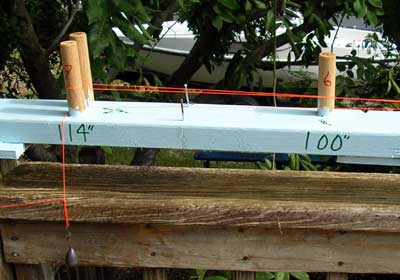
A view of the last stage of completing your first strand. Notice that the weight is keeping tension on the completed loops; this allows you to cut the spool free (which has not yet been done in this photo) and move on to your second strand.
You have now spun half of your leader, clockwise. Complete the same procedure now with your other strand, spinning clockwise also, but leave the second strand on the drill hook.
After spinning both strands, take your first spun strand, and hook it back on to your drill hook with the strand you just spun. Now, switch your drill so as to turn counterclockwise. Please don’t forget to go in the opposite direction: you’ve got some time invested now. Spin your two clockwise strands for 45 seconds, again counterclockwise.
Congratulations! The rest is a piece of cake. All the ones you make from here on will take ten minutes, start to finish, believe me. Making a knotted leader, you’d still be tying knots, with strawberry chap stick on your summer lips, standing on your knotted leader and pulling until you get second degree burns on your pulling hand and swearing that you’ll remember to wear a glove next time. Sorry. I wasn’t going to hype furled leaders any more. Besides, you are probably thinking There must be another step. Indeed. You need to finish your leader.
Now unhook one end and then the other of your furled strands and holding them between finger and thumb; to make things even simpler you can attach forceps to one end of the leader. Your leader will want to contract like a twisted rubber band. Don’t worry: that’s normal. It won’t come unfurled, though attaching forceps makes the mind rest easier. Now hold one end up, let go of the other, and let it spin.
When it stops spinning you are ready to put loops on each end for attaching the running line and the tippet. There is a way to make these loops without using a knot, but since you’re already digested a lot of information here, I’ll refer you to the instructions by Mike McGuire, who’s listed in the references. Quite honestly, though, I prefer to whip finish mine, and here’s a quick tutorial:
Make a loop the size you prefer, and in the manner you would wrap a hook shank if you are a fly tier. Start wrapping a few turns, then twirl the bobbin around, ninety to nothing between your fingers, spaced about a half-inch apart. I end with about four whipped hitches at the top, a drop or two of Super Glue, and clip off the excess leader smooth to the bottom of the whipped loop.
When you have whip-finished both ends, you’re almost ready to go fishing. But before you do, coil it up around your hand, then holding either end, let it uncoil. It fell straight as an arrow didn’t it? Your leader is as soft as a baby’s bottom, isn’t it? It’s tapered nicely and is a thing of beauty. You made it yourself, and heck, it was almost as much fun as tying a knotted leader that’s unfortunately only as strong as its weakest knot. Oops, I did it again. Sorry. Multiply your total of 18 wraps by 4 and your leader has a theoretical strength of 72 pounds at the top, and tapers to 6 times 4 or 24 pounds at the bottom.
Thanks for helping me make a case for a furled leader. You did very well, indeed.
End Note — Though I first heard of furled leaders through Hans Weilenmann, an article on Global FlyFisher by Henk Verhaar was what really piqued my interest, and I am quite sure that all Americans who make furled leaders have been influenced by Henk Verhaar’s article. Some keep their technique close to the vest but will send you one of their leaders for a penny less than $15. I am referencing only those who credit Mr. Verhaar’s influence, who have also recognized his copyright, and the spirit he has offered his instructions for non-commercial dissemination among fly fishers. The references below represent variations and additions deemed by the authors to be the best for targeting various species of fish.
